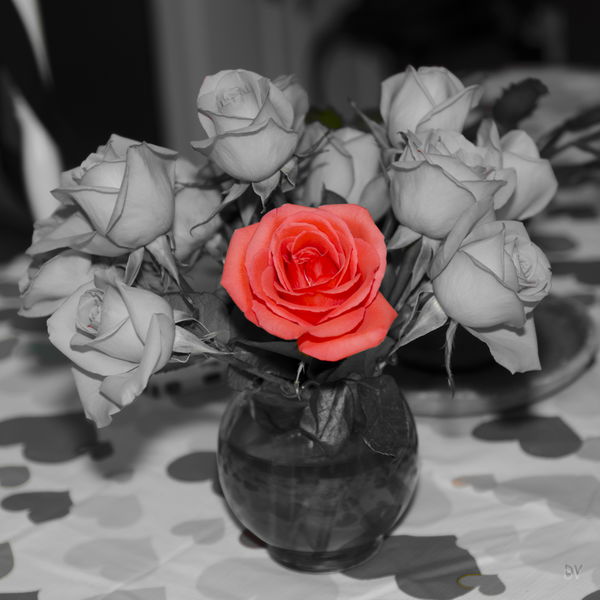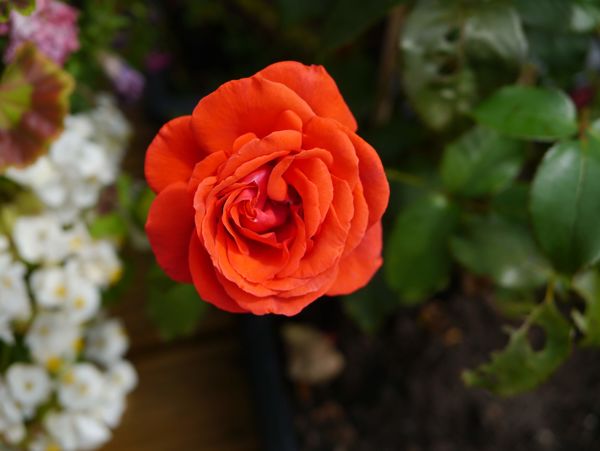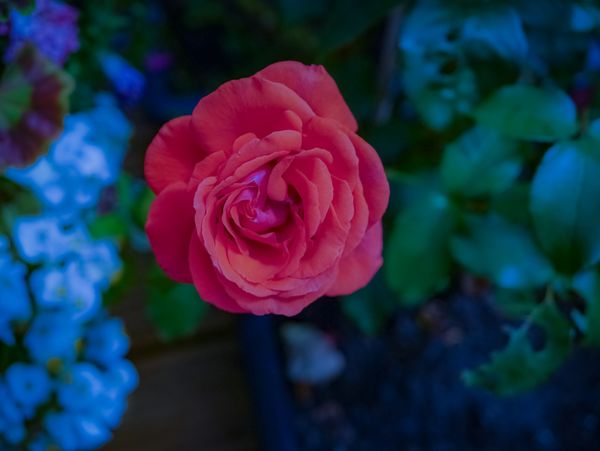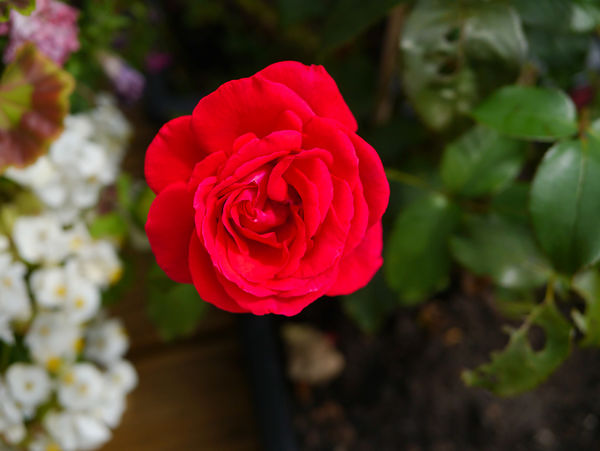Photographing Red Roses
Aug 4, 2018 07:11:59 #
I have lovely red rose bush which is just beginning to bloom. Has anyone got some tips on how to get the colour red correct?
I know digital cameras have a problem with red but there must be a method to get around this.
Here is an example I took earlier.
Thanks.
I know digital cameras have a problem with red but there must be a method to get around this.
Here is an example I took earlier.
Thanks.
Aug 4, 2018 07:31:13 #
Reds are one of the most difficult colors to duplicate. Every medium poses a different challenge, its all relative.....print, screen etc.... go with the artist in you and save the pain and dont worry about matchy match.
Enjoy
Enjoy
A Rose alone is still a Rose

Aug 4, 2018 07:38:27 #
johneccles wrote:
I have lovely red rose bush which is just beginning to bloom. Has anyone got some tips on how to get the colour red correct?
I know digital cameras have a problem with red but there must be a method to get around this.
Thanks.
I know digital cameras have a problem with red but there must be a method to get around this.
Thanks.
You need to avoid blowing the red highlights. If you shoot in Auto mode, a red flower with a dark background might overexpose the red channel.
If you expose in broad daylight on Manual using Sunny 16 (1/ISO @ f/16 or equivalent) you should be able to keep the red channel from blowing out.
Negative color film does not have this problem because the highlights don't blow out suddenly like they do with digital.
Aug 4, 2018 08:13:26 #
johneccles wrote:
I have lovely red rose bush which is just beginning to bloom. Has anyone got some tips on how to get the colour red correct? I know digital cameras have a problem with red but there must be a method to get around this. Here is an example I took earlier. Thanks.
John - Here with deep humility is my take on the rose - edited this morning on my iPad Pro using Lightroom CC v3.3.1. Obviously I did not have the advantage of being there to see the flower and setting for myself. My efforts may not be perfect; they managed to turn your white flowers blue. I truly hope you will not find this pastiche offensive. — Ralph
Aug 4, 2018 09:11:42 #
I took your Rose and improved it some but it took several layers in Photoshop increasing reds and blues. As I did this is affected the background so I made a mask just for the rose. Another problem it became soft so then applied a high pass filter set to Vidid and got some edges back. If you would like to see the results let me know.
Now that is what I did to improve your supplied picture.
For the future.
I think you are shooting .jpg or .tif. I don't have much experience shooting .tif to give you advice, I shoot raw 95% of the time. But if you are shooting .jpg start changing your Withe balance settings. Write down each of your available white balance settings on a sheet of paper. Now shoot the rose at each one of the settings in the order you wrote them down. Take them over to the computer and review. You should see a different color at different settings. You might find that overcast or one of the other setting does a better job. Hope you find this information works to help your reds.
Jim
Now that is what I did to improve your supplied picture.
For the future.
I think you are shooting .jpg or .tif. I don't have much experience shooting .tif to give you advice, I shoot raw 95% of the time. But if you are shooting .jpg start changing your Withe balance settings. Write down each of your available white balance settings on a sheet of paper. Now shoot the rose at each one of the settings in the order you wrote them down. Take them over to the computer and review. You should see a different color at different settings. You might find that overcast or one of the other setting does a better job. Hope you find this information works to help your reds.
Jim
Aug 4, 2018 09:26:34 #
Jim-Pops wrote:
I took your Rose and improved it some but it took several layers in Photoshop increasing reds and blues. As I did this is affected the background so I made a mask just for the rose. Another problem it became soft so then applied a high pass filter set to Vidid and got some edges back. If you would like to see the results let me know. ...
You can't post process the JPEG image to overcome the fact that it is overexposed by nearly two stops. Take a look at the highlights in the brightest red parts of the petals. You will find that the red values are about 254 and 255, a clear indication that the red channel is blown.
The exposure was 1/2000 @ f/2.5 and ISO 160. That works out to a net EV of 13. Sunny 16 is a net EV of 14.7.
A net EV=15 is a little safer. An aperture of f/5 would have accomplished that and the resulting JPEG would be easier to work with. Developing from the raw file would have made it easy to recover some shadow information.
Aug 4, 2018 10:20:39 #
Aug 4, 2018 10:28:39 #
Aug 4, 2018 10:30:16 #
Jim-Pops wrote:
Here is what I got Scottie
The brightest reds are still at 255. You can't fix blown highlights in a JPEG.
Aug 4, 2018 10:38:49 #
johneccles wrote:
I have lovely red rose bush which is just beginning to bloom. Has anyone got some tips on how to get the colour red correct?
I know digital cameras have a problem with red but there must be a method to get around this.
Here is an example I took earlier.
Thanks.
I know digital cameras have a problem with red but there must be a method to get around this.
Here is an example I took earlier.
Thanks.
My Nikon camera histograms are RGB and can be set in-camera so that I can check just the red histogram to ensure it is not blown out. Put your focus-exposure point directly on the brightest red of the rose. I'd use a more wide open aperture so as to blur the background, you can experiment with it. You may need to use -exposure compensation to obtain all of the red color. You will most likely end up with a darken than wanted shot and you can pull up the shadows in post if you want to. In LR you can also check the red histogram only to ensure that it is not blown out and can try correcting just the red histogram, which may help to some degree.
Aug 4, 2018 22:14:06 #
I brought up this subject myself a couple years ago. I think the answer is to dial back the red saturation a bit in post processing. Red is hard for the sensor to process so we have to adjust it a little to make it look like we remember it.
Aug 5, 2018 04:56:34 #
I have tried "Sunny 16" as you suggested, it did make some difference, the only thing was I had a problem with focus if I got too near.
Thanks.
Thanks.
Aug 5, 2018 04:58:06 #
rjaywallace wrote:
John - Here with deep humility is my take on the rose - edited this morning on my iPad Pro using Lightroom CC v3.3.1. Obviously I did not have the advantage of being there to see the flower and setting for myself. My efforts may not be perfect; they managed to turn your white flowers blue. I truly hope you will not find this pastiche offensive. — Ralph
No problem, thank you for you efforts.
Aug 5, 2018 05:04:31 #
selmslie wrote:
You can't post process the JPEG image to overcome ... (show quote)
That's very good, I will take some more today and try your suggestions out.
Thanks
Aug 5, 2018 05:06:21 #
via the lens wrote:
My Nikon camera histograms are RGB and can be set ... (show quote)
Thank you, I will your suggestions out later.
If you want to reply, then register here. Registration is free and your account is created instantly, so you can post right away.








